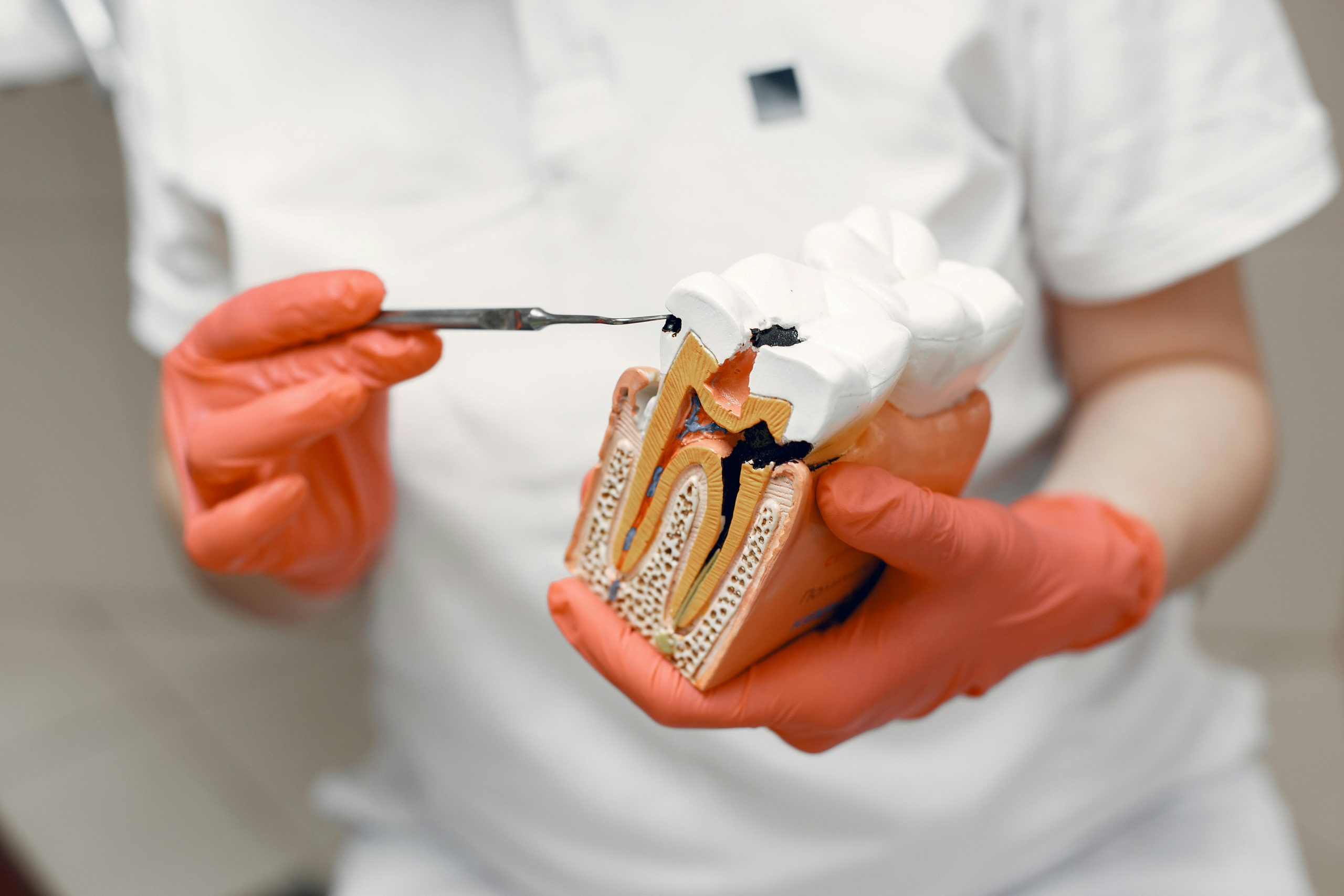
If you’ve ever asked, “Are cavities contagious?”—you’re not alone. Many people think of cavities as a solo problem, caused by too much sugar and poor brushing. But studies suggest something surprising: cavities might actually be transmissible. Yes, tooth decay can spread—like a cold or the flu, though in a slightly different way.
In this article, we’ll explore what science says about the contagious nature of cavities, how the bacteria behind them travel, and what you can do to protect yourself and your loved ones from shared oral bacteria.
What Is a Cavity and How Does It Form?
To understand how cavities spread, it’s essential to first understand what a cavity is. A cavity—technically called dental caries—is a permanently damaged area in the hard surface of your tooth that develops into tiny openings or holes.
Cavities form through a process called “demineralization”:
- Sugar and starches in the mouth feed bacteria.
- These bacteria produce acid as a byproduct.
- The acid gradually erodes the enamel, the tooth’s protective layer.
- If not removed through brushing or neutralized with saliva or fluoride, the enamel breaks down, creating a cavity.
Key bacteria involved include:
- Streptococcus mutans
- Lactobacillus acidophilus: These bacteria are particularly good at producing acid and adhering to teeth via plaque.
So, Are Cavities Contagious?

In short, yes—indirectly. While you can’t “catch” a cavity like the flu, the bacteria that cause cavities are indeed contagious. This means that one person can transmit the bacterial agents responsible for tooth decay to another person through common forms of contact.
The scientific consensus:
- The bacteria associated with cavities are transmissible via saliva.
- The transmission of these bacteria creates a more cavity-prone oral environment for the recipient.
- Once established, these bacteria can become part of a person’s permanent oral flora.
So, while the hole in the tooth doesn’t spread, the microscopic culprits behind it certainly can.
How Do Cavity-Causing Bacteria Spread Between People?
The primary route of transmission is saliva exchange. Saliva is rich in microorganisms, including both beneficial and harmful bacteria. When saliva is shared, so too is the bacterial population.
Common behaviors that spread cavity-causing bacteria:
- Kissing: Deep or prolonged kissing can transmit oral bacteria from one person to another.
- Sharing eating utensils: Especially common among couples or between parents and children.
- Using the same toothbrush: This is highly unhygienic and a direct route for bacteria transmission.
- Blowing on food or testing it: Parents often do this to cool down a child’s food, unknowingly spreading bacteria.
- Tasting food off someone else’s spoon or fork: Casual food-sharing habits can pose long-term dental risks.
These behaviors, while common, provide a consistent opportunity for Streptococcus mutans to travel between mouths.
Who Is Most Vulnerable to Transmitted Cavities?
While everyone can be affected by cavity-causing bacteria, certain populations are more vulnerable due to age, behavior, or immune system status.
1. Infants and Young Children
- Newborns are not born with cavity-causing bacteria.
- They typically acquire these bacteria from parents or primary caregivers between the ages of 6 months and 2.5 years.
- Studies show that mothers are the most common source, especially if they have untreated tooth decay.
2. Couples and Partners
- Long-term couples often share an oral microbiome due to frequent intimate contact.
- If one partner has poor oral health, the other becomes at higher risk for acquiring their bacteria.
3. Immunocompromised Individuals
- People undergoing chemotherapy, those with autoimmune diseases, or elderly individuals often have weakened immune systems, making them more susceptible to bacterial colonization and infection.
4. People with Braces or Dental Appliances
- Brackets and retainers create areas where bacteria can accumulate and thrive.
- If oral hygiene is suboptimal, it becomes easier for transmitted bacteria to multiply.
Scientific Studies That Prove Cavities Can Spread
Researchers have studied the transmissibility of oral bacteria for decades. The idea that cavities are communicable isn’t new—but it has gained more attention in recent years.
Notable findings include:
- Mother-to-child transmission: A landmark study published in the Journal of Dental Research confirmed that Streptococcus mutans was often passed from mother to child during early developmental stages. Children of mothers with untreated cavities were more likely to develop tooth decay at a young age.
- Romantic relationships: A study investigating married Chinese couples found evidence that S. mutans strains can be shared between spouses. In this research, plaque samples from both partners were genotyped, and in some cases identical bacterial strains were found in both partners—strongly suggesting direct transmission through close contact
- Saliva as a carrier: Researchers found that oral bacteria could survive and thrive after being transferred through saliva, especially in individuals who had compromised enamel or poor hygiene.
These studies highlight the fact that once introduced, cavity-causing bacteria can establish themselves long-term in the mouth.
What Makes These Bacteria So Harmful?
Understanding the behavior of cavity-causing bacteria helps explain why they’re so effective—and dangerous—once transmitted.
Characteristics of Streptococcus mutans and friends:
- Adhesive power: These bacteria produce sticky substances that allow them to cling to tooth enamel.
- Acid production: They convert sugars into acid, lowering the pH level in the mouth.
- Resilience: Once they colonize, they’re hard to eliminate without sustained oral hygiene.
- Biofilm formation: These bacteria form plaque—a biofilm that protects them from saliva, brushing, and even some antibacterial agents.
In short, once these bacteria make a home in your mouth, they create a mini-ecosystem that thrives on sugar and erodes tooth enamel over time.
How to Prevent the Spread of Cavity-Causing Bacteria

Though you can’t live in a bubble, there are practical steps you can take to minimize the risk of spreading or acquiring harmful oral bacteria.
Best practices for prevention:
- Don’t share oral items
- Always use your own toothbrush, water bottle, and utensils.
- Avoid kissing babies on the lips, especially if you have untreated cavities.
- Brush and floss properly
- Use fluoride toothpaste twice daily.
- Floss daily to remove bacteria between teeth that brushing can’t reach.
- Visit the dentist regularly
- Professional cleanings help remove plaque and tartar that harbor bacteria.
- Early detection of cavities can prevent transmission through shared saliva.
- Maintain a balanced diet
- Limit sugar intake, particularly sticky candies and sugary drinks.
- Opt for foods that promote saliva production, like fibrous vegetables and cheese.
- Use antimicrobial mouthwash
- Consider a mouth rinse containing chlorhexidine or essential oils to reduce bacterial load.
Specific Tips for Parents of Young Children
Since babies and toddlers are especially vulnerable, parents and caregivers must take extra precautions to prevent early transmission.
Do:
- Clean bottles, pacifiers, and teething rings with hot water and soap—not your mouth.
- Begin brushing your child’s teeth with a rice-sized amount of fluoride toothpaste as soon as they erupt.
- Schedule your child’s first dental visit by their first birthday.
- Practice good personal oral hygiene to reduce your own bacterial load.
Don’t:
- Share spoons, cups, or straws with your child.
- Blow on your child’s food to cool it.
- “Clean” a dropped pacifier with your mouth.
Living With Someone Who Has Cavities: What You Should Know
If a partner or family member has untreated tooth decay, it doesn’t mean you’re doomed—but it does mean you should be cautious.
Steps to reduce risk in close-contact households:
- Encourage your partner to treat active decay.
- Don’t store toothbrushes too close together (bacteria can spread via moisture).
- Disinfect or replace your toothbrush every 3 months—or after being sick.
- Avoid deep kissing if one partner has significant untreated decay or gum disease.
Can Oral Probiotics Help?
Recent studies suggest that oral probiotics—live, beneficial bacteria—may help counter the negative effects of S. mutans and restore microbial balance.
While research is still emerging, oral probiotics have shown potential to:
- Decrease plaque formation
- Reduce the number of cavity-causing bacteria
- Promote a more stable pH in the mouth
Ask your dentist about available probiotic lozenges, rinses, or supplements if you’re concerned about long-term bacterial exposure.
Cavity Contagion: Myth vs. Fact
| Statement | True or False | Explanation |
| You can catch a cavity from someone else. | Partially true | You can catch the bacteria that lead to cavities. |
| Only sugar causes cavities. | False | Sugar feeds bacteria, but hygiene and pH also matter. |
| Kids get cavities from eating too many sweets. | Sometimes true | More often, it’s poor hygiene + bacterial exposure. |
| Sharing food with your child is harmless. | False | Saliva-sharing can transmit cavity-causing bacteria. |
When to See a Dentist
Regular checkups are essential, but you should also visit a dentist if you notice any of the following:
- Tooth sensitivity to temperature or sweets
- Persistent bad breath
- Dark spots or visible holes in teeth
- Pain when chewing or biting
- Bleeding gums or inflammation
Early detection not only prevents tooth loss but also reduces the risk of spreading decay-causing bacteria to others.
Conclusion: Should You Be Concerned About Cavity Transmission?
While cavities themselves are not contagious in the traditional sense, the bacteria responsible for them can be shared through common behaviors. Awareness and prevention are your best tools.
Good oral hygiene, regular dental visits, and minimizing saliva-sharing habits—especially with children—can significantly reduce the risk of bacterial transmission.
Understanding that cavities are influenced by social behavior gives you the power to not only improve your own oral health but also protect those around you.
Final Checklist: Cavity Prevention for You and Your Family
- Brush twice daily with fluoride toothpaste
- Floss daily
- Avoid sharing cups, utensils, and toothbrushes
- Visit your dentist every 6 months
- Limit sugary foods and drinks
- Use mouthwash to reduce bacteria
- Be mindful of your oral health before interacting with children
